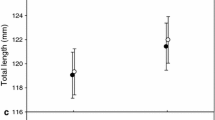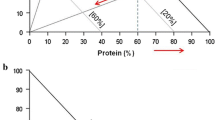Summary
We examined how prey size-distributions influence size-specific foraing rate and food gain, i.e., food intake scaled to metabolic demands, in Jefferson's and small-mouth salamander larvae. Ambystoma jeffersonianum larvae sampled on 17 dates from a farm pond whose fauna was dominated by macrozooplankton and chironomid larvae were rarely gape-limited, and total volume of food in the stomach (VS) showed only a slight tendency to increase with larval size. Although 15 of 17 correlation coefficients of VS with larval size were positive, only 1 of 17 correlations were statistically significant, and body size explained only 8% of the overall variation in VS. Correlation coefficients of food gain and body size were positive in 9 cases and negative in 8, but only 3 were statistically significant.
In contrast, Ambystoma texanum larvae in 42 samples taken from five sites dominated by macrozooplankton as well as relatively large isopods and amphipods were almost always gape-limited, and VS tended to increase markedly with larval size. 40 of 42 correlation coefficients of VS and larval size were positive, and 19 correlations were statistically significant. Body size in turn explained about 35% of the overall variation in VS. Correlation coefficients of food gain and larval size were positive in 32 of 42 samples, and 9 of 10 significant correlations were positive.
When food is limiting and prey selection is not limited by gape, smaller larvae may grow as fast or in some cases faster than larger larvae because they are nearly as effective foragers, but have lower metabolic demands. Larger larvae may in turn grow faster than smaller larvae in environments which support a broad size spectrum of prey, particularly when gape limitations are highly disproportionate among size classes. The growth rate of larvae in one size class relative to another depends primarily on the extent to which increased foraging rate compensates for higher energy demands as body size increases. Size-specific foraging rate may in turn be strongly influenced by the prey size-distribution within a habitat. These relationships suggest that relative size is not always a good a priori predictor of exploitative competitive ability.
Similar content being viewed by others
References
Anderson JD, Graham RE (1967) Vertical migration and stratification of larval Ambystoma. Copeia 1967:371–374
Branch L, Altig R (1981) Nocturnal stratification of three species of Ambystoma larvae. Copeia 1981:870–873
Brooks JL, Dodson SI (1965) Predation, body size, and composition of plankton. Science 150:28–35
Collins J, Cheek D (1983) Effect of food and density on development of typical and cannibalistic salamander larvae in Ambystoma tigrinum nebulosum. Amer Zool 23:77–84
Huey RB, Pianka ER (1981) Ecological consequences of foraging mode. Ecology 62:982–990
Keast A (1977) Mechanisms expanding niche width and minimizing intraspecific competition in two centrarchid fishes. Evol Biol 10:333–395
Lind OT (1974) Handbook of common methods in limnology. CV Mosby Co, St Louis
Persson L (1985) Asymmetrical competition: are larger animals competitively superior? Am Nat 126:261–266
Petranka JW (1984a) Ontogeny of the diet and feeding behavior of Eurycea bislineata larvae. J Herpetol 18:48–55
Petranka JW (1984b) Sources of interpopulational variation in growth responses of larval salamanders. Ecology 65:1857–1865 32, 1035–1039
Petranka JW, Sih A (1986) Environmental instability, competition, and density-dependent growth and survivorship of a streamdwelling salamander. Ecology 67:729–736
Polis GA (1984) Age structure component of niche width and intraspecific resource partitioning: can age groups function as ecological species? Am Nat 123:541–564
Ray AA (1982a) SAS user's guide: basics. SAS Institute, Cary, North Carolina, USA
Ray AA (1982b) SAS user's guide: statistics. SAS Institute, Cary, North Carolina, USA
Richards CM (1962) The control of tadpole growth by algae-like cells. Physiol Zool 35:285–296
Rose SM (1960) A feedback mechanism of growth control in tadpoles. Ecology 41:188–196
Schoener TW (1983) Field experiments on interspecific competition. Am Nat 103:227–313
Smith CK (1982) The ecology of the larvae of Ambystoma jeffersonianum. Unpublished Masters Thesis, University of Kentucky, p 140
Smith D (1983) Factors controlling tadpole populations of the chorus frog (Pseudacris triseriata) on Isle Royale, Michigan. Ecology 64:501–510
Steinwasher K (1978) Interference and expoitative competition among tadpoles of Rana utricularia. Ecology 59:1039–1046
Stewart MM (1956) The separate effects of food and temperature differences on development of marbled salamander larvae. J Elisha Mit Sci Soc 72:47–56
Werner E, Gilliam J (1984) The ontogenetic niche and species interactions in size-structured populations. Ann Rev Ecol Syst 15:393–425
Whitford WG, Hutchison, VH (1967) Body size and metabolic rate in salamanders. Phy Zool 40:127–133
Wilbur HM, Collins JP (1973) Ecological aspects of amphibian metamorphosis. Science 182:1305–1314
Wilson DS (1975) The adequacy of body size as a niche difference. Am Nat 109:769–784
Zaret TM (1980) Predation and freshwater communities. Yale University Press, New Haven
Author information
Authors and Affiliations
Rights and permissions
About this article
Cite this article
Smith, C.K., Petranka, J.W. Prey size-distributions and size-specific foraging success of Ambystoma larvae. Oecologia 71, 239–244 (1987). https://doi.org/10.1007/BF00377290
Received:
Issue Date:
DOI: https://doi.org/10.1007/BF00377290




